Sparrow
There are more sparrows in the world than people.
Advertisement
Sparrow Scientific Classification
Read our Complete Guide to Classification of Animals.
Sparrow Conservation Status
Sparrow Facts
- Main Prey
- Insects, Seeds, Berries
- Fun Fact
- There are more sparrows in the world than people.
- Estimated Population Size
- 1.6 billion
- Distinctive Feature
- Small body size and rounded head
- Wingspan
- 8.3 inches
- Incubation Period
- 10 to 14 days
- Habitat
- Countryside and woodland
- Predators
- Cats, Snakes, Hawks
- Diet
- Omnivore
- Lifestyle
- Flock
- Type
- Bird
- Average Clutch Size
- 4
- Slogan
- There are 140 different species!
- Nesting Location
- On or around buildings
- Age of Molting
- 82 days
View all of the Sparrow images!
“No matter where on Earth you live, sparrows likely visit your backyard.”
Sparrows are a common sight the world over. Eurasian house sparrows and tree sparrows are among the most common. Not only do they occupy a large natural range, but they’ve invaded several continents as settlers took the birds with them. These birds have adapted well to living near people, from cities to farm fields.
These birds have been symbols in songs, pets, and food sources. You can learn more about this small bird that has played a role in human lives throughout history.
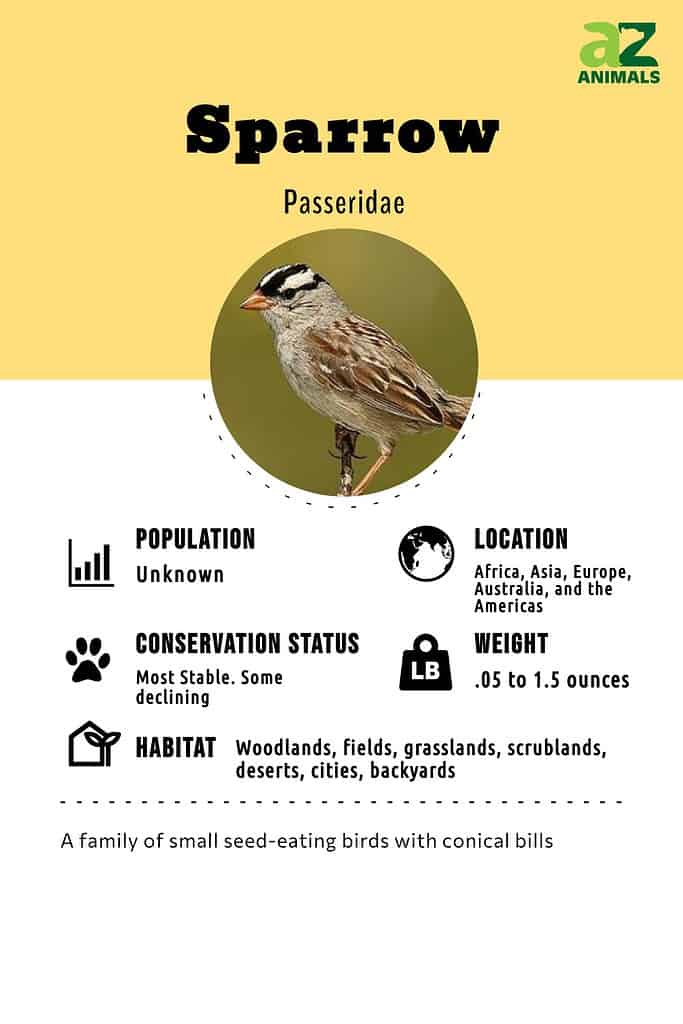
3 Amazing Facts!
- These birds have an extra bone in their tongues. It makes the tongue stiff so that it can be used to hold seeds.
- These birds can fly 24 to 31 miles per hour (38.5 to 50 km/hr.)
- They are mentioned in many ancient books and manuscripts, including the Bible.
Habitat: Where To Find Them

Sparrows are easy to attract to your backyard.
©fewerton/Shutterstock.com
Old World species are native to Africa, Asia, and Europe, but they have been naturalized in the Americas and Australia. New World sparrows live in the Americas.
The bird’s natural habitat is that of open woodlands, fields, grasslands, scrubland, and deserts. They have adapted well to life around humans, and they can be found in cities and neighborhoods in large numbers. If you want to view These birds, you are certain to attract them with a backyard bird feeder.
Scientific Names
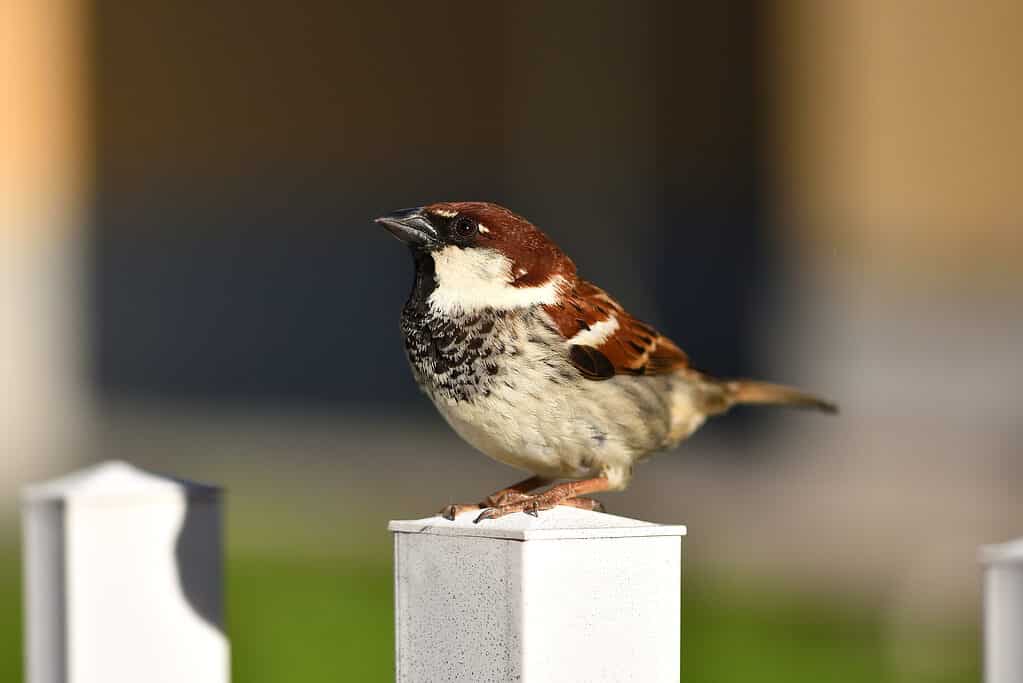
The common Italian sparrow is the national bird of Italy.
©Davide Bonora/Shutterstock.com
Most of these birds are classed as Old World or New World sparrows. The Old World species are also called “true sparrows.” They make up eight genera in the family Passeridae, superfamily Passeroidae, infraorder Passerida, suborder Passeri, order Passeriformes, class Aves (birds), phylum Chordata, and kingdom Animalia.
The 43 species of Old World sparrows with their scientific names include:
- Abd al-Kuri sp. (Passer hemileucus)
- Afghan snowfinch (Montifringilla theresae)
- Arabian golden sp. (Passer euchlorus)
- Black-winged snowfinch (Montifringilla adamsi)
- Blanford’s snowfinch (Montifringilla blanfordi)
- Cape sp.(Passer melanurus)
- Chestnut sp. (Passer eminibey)
- Cinnamon ibon (Hypocryptadius cinnamomeus)
- Dead Sea sp. (Passer moabiticus)
- Desert spa. (Passer simplex)
- Eurasian tree sp. (Passer montanus)
- Great sp. (Passer motitensis)
- House sp. (Passer domesticus)
- Iago sp. (Passer iagoensis)
- Italian sp. (Passer italiae)
- Kenya sp. (Passer rufocinctus)
- Kordofan sp.(Passer cordofanicus)
- Northern grey-headed sp. (Passer griseus)
- Pale rockfinch (Carpospiza brachydactyla)
- Parrot-billed sp. (Passer gongonensis)
- Père David’s snowfinch (Montifringilla davidiana)
- Plain-backed sp. (Passer flaveolus)
- Rock sp. (Petronia petronia)
- Rufous-necked snowfinch (Montifringilla ruficollis)
- Russet sp. (Passer cinnamomeus)
- Sahel bush sp. (Gymnoris dentata)
- Saxaul sp. (Passer ammodendri)
- Shelley’s sp. (Passer shelleyi)
- Sind sp. (Passer pyrrhonotus)
- Socotra sp. (Passer insularis)
- Somali sp. (Passer castanopterus)
- Southern grey-headed sp. (Passer diffusus)
- Spanish sp. (Passer hispaniolensis)
- Sudan golden sp. (Passer luteus)
- Swahili sp. (Passer suahelicus)
- Swainson’s sp. (Passer swainsonii)
- Tibetan snowfinch (Montifringilla henrici)
- White-rumped snowfinch (Montifringilla taczanowskii)
- White-winged snowfinch (Montifringilla nivalis)
- Yellow-spotted bush sp. (Gymnoris pyrgita)
- Yellow-throated bush sp. (Gymnoris superciliaris)
- Yellow-throated sp. (Gymnoris xanthocollis)
- Zarudny’s sp. (Passer zarudnyi)
There are around 138 species of New World sparrows divided into 29 genera. These birds are more closely related to Old World finches than to Old World sparrows. The chipping, white-throated, and field sparrows are examples of New World sparrows.
Other sparrows include the Java (scientific name Lonchura oryzivora) and Timor sparrows (L. fuscata) of the family Estrilididae and the dunnock or hedge accentor (Prunella modularis) of the family Prunelidae.
Evolution

Sparrows have a mysterious evolutionary history.
©iStock.com/Ian Fox
It is hard to account for the history of house sparrows because they are so ubiquitous. We have a tendency to overlook commonplace creatures, and even scientists would rather study rare species than those that are common. The story of the relationship between sparrows and humans is ancient and incomplete, much like our own history. As a result, it is difficult to tell the story of the house sparrow accurately.
Evidence of the house sparrow first appears in Africa, and two jawbones belonging to a bird called Passer predomesticus were found in Israel in sediment more than 100,000 years old. After this, other birds similar to the modern house sparrow began appearing in the fossil record approximately 10,000 or 20,000 years ago. These birds had distinct features on their mandibles, like a crest of bone where there had been only a furrow before.
As humans spread agriculture across the world, house sparrows spread with them and evolved to adapt to the different regions. This caused sparrows around the globe to all originate from one single line of descent. House sparrows have continued to evolve as humans have taken them to different environments, leading scientists to classify them into subspecies and even species. An example of this is when house sparrows met with Spanish sparrows in parts of Italy, forming a hybrid species called the Italian sparrow.
Size, Appearance, & Behavior
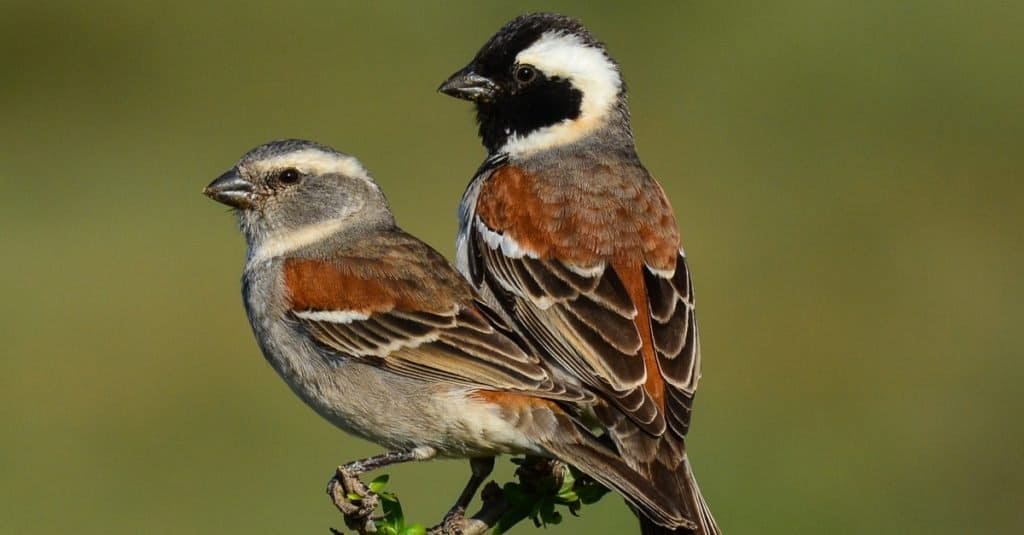
Sparrows like to forage for food together.
©Michael Potter11/Shutterstock.com
These are small brown and gray birds with conical or cone-shaped beaks. Some, like the red-headed chipping and white-throated sparrows, have distinctive markings on their heads. Others, like the song sparrow, are blotched in brown and cream. Finches, such as the red-headed house finch, are often mistaken for sparrows.
The smallest is the chestnut sparrow. It is 4.5 inches (11.4) long and weighs less than half an ounce (13.4g). The largest is the parrot-billed sparrow, which weighs in at 1.5 oz (42g) and has a length of 7.1 inches (18 cm).
These birds forage in small to large flocks. Many species may be present in a single flock. This changes at mating time, when the flock is limited to just one type of sparrow. Abundant varieties include song, chipping, white-throated, and red-headed sparrows.
A unique behavior of these birds is dust bathing. The bird scratches a hole in the ground with its feet, settles into it, and flings dust onto its body using its wings. They also like to bathe in puddles.
Migration Pattern and Timing
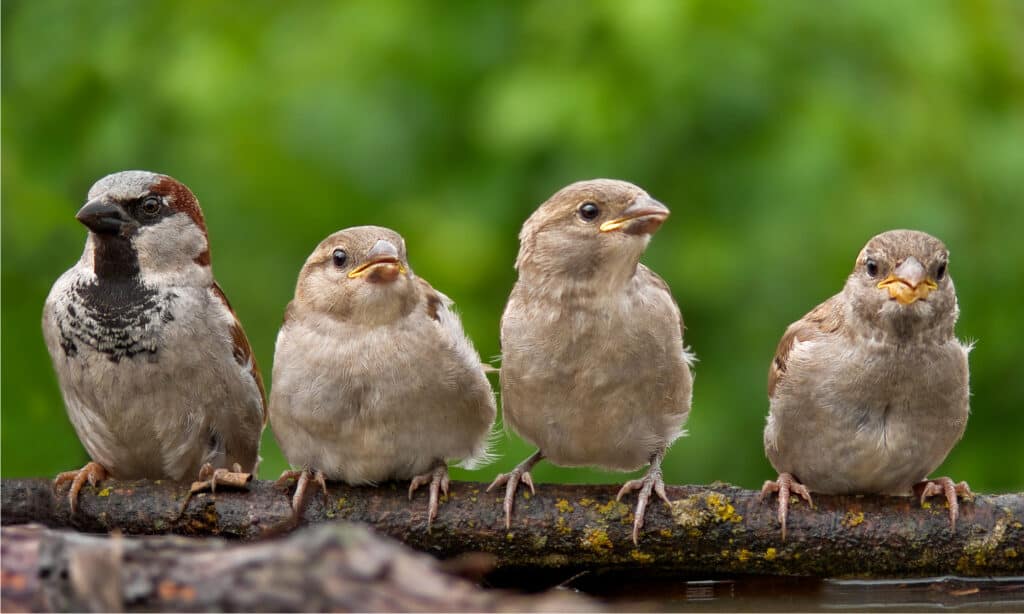
Some sparrows migrate south for winter.
©Nick Vorobey/Shutterstock.com
Many types of sparrows survive cold or inclement weather by retreating into the eaves of buildings, tree cavities, or even behind sections of loose tree bark. Others, such as the American tree sparrows, migrate south to find warmer weather.
Sparrows are small, brown birds that migrate seasonally. During their migration, sparrows travel in large groups and fly from one place to another to find food or a more suitable climate for nesting. Sparrows usually migrate during the fall months when temperatures start to drop and food sources become scarce. They can be seen flying in tight formations as they make their way southward. This helps them stay together as a group and also provides protection against predators such as hawks. Some sparrows will even take breaks along the way at stopover sites where they can rest before continuing on with their journey. It is estimated that some species of sparrows have traveled over 10,000 miles during their migrations!
Diet
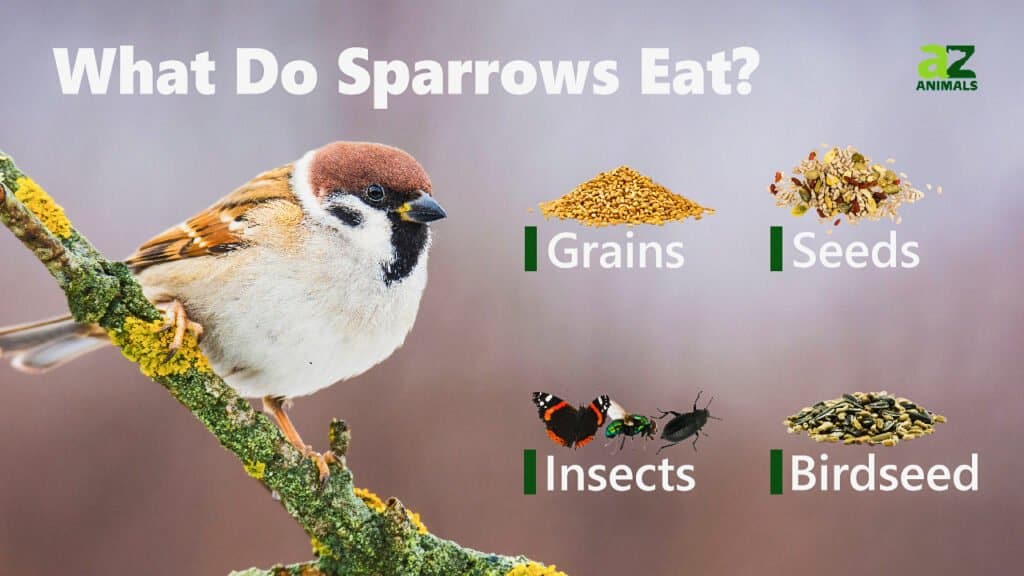
These birds are opportunistic feeders. Sparrows mainly eat seeds and grains, but they will also supplement their diet with insects, fruits, and other small animals such as spiders or snails. Sparrows typically hunt for food by hopping along the ground, looking for insects to eat, or searching trees and shrubs for berries or seeds. They may also scavenge around human dwellings looking for crumbs that have been left behind. To get a better view of their surroundings while hunting, sparrows often perch atop branches or telephone wires.
Predators and Threats
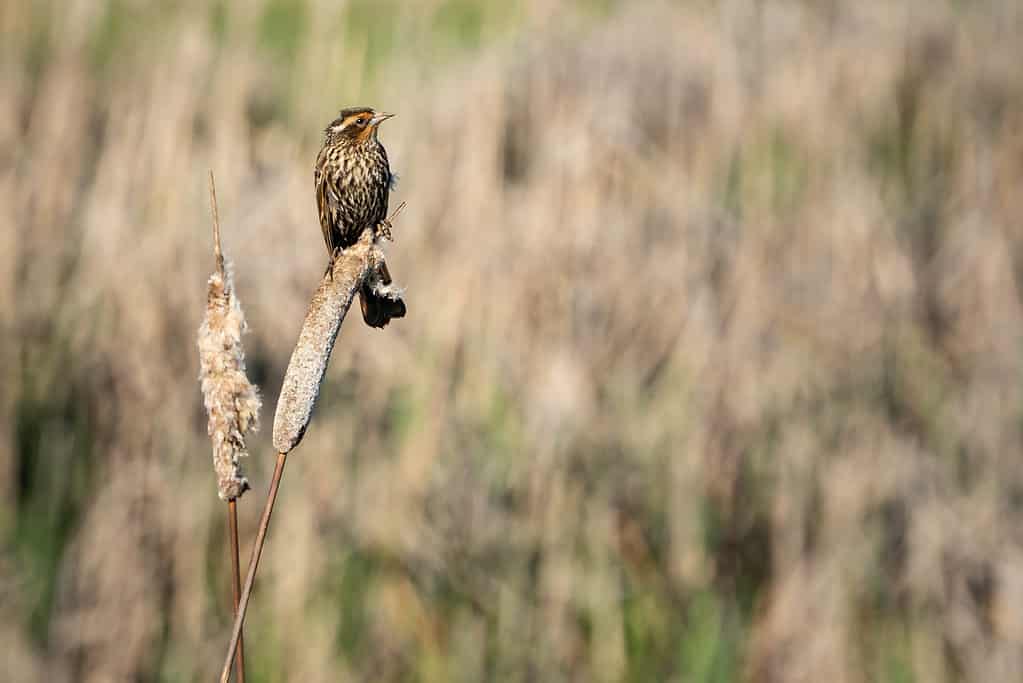
Saltmarsh sparrows have to watch out for large birds of prey.
©iStock.com/wirestock
Hawks, owls, and cats commonly hunt adult birds. Young flightless birds and unhatched eggs are preyed upon by raccoons and snakes. Crows, jays, and grackles may also eat the eggs.
In some parts of the world, people eat these birds. People have also been a threat to sparrows through intentional and unintentional agricultural poisoning.
What Eats Sparrows?
Birds of prey, cats, snakes, and sometimes people are their predators.
Reproduction, Babies, and Lifespan
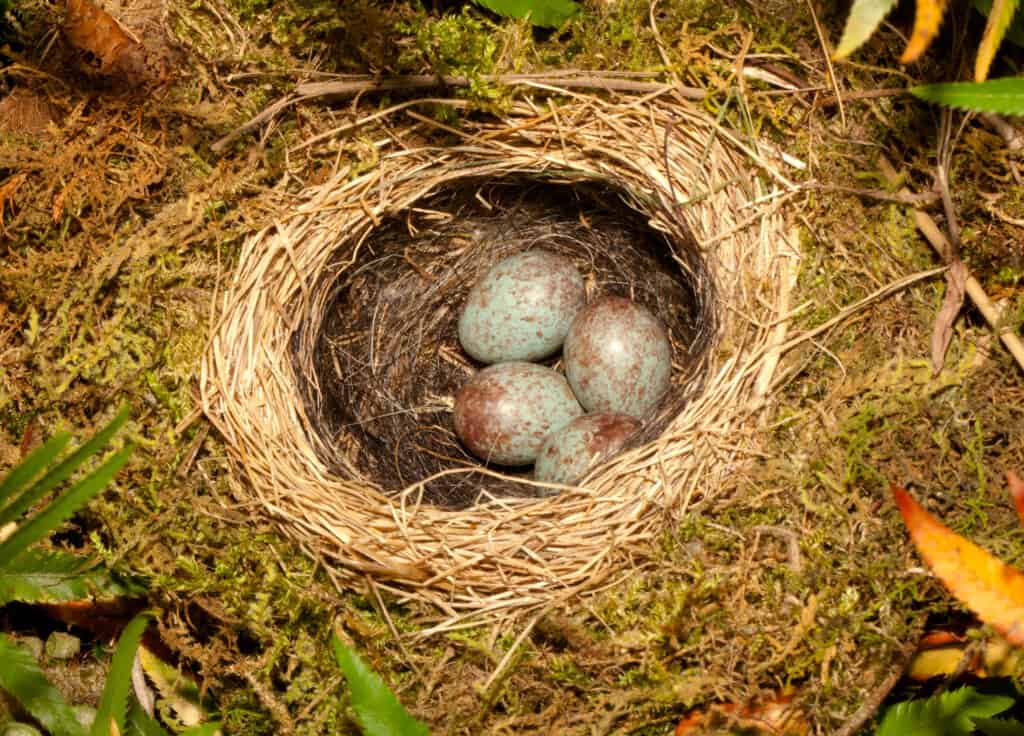
Sparrows will use the same nest year after year if it is undisturbed.
©Tom Middleton/Shutterstock.com
Sparrows are social and colonial in their habits, meaning they live in large groups or flocks. These groups have been known to include up to 10,000 individuals. The exception is the great spa., which prefers small family groups and breeds only in pairs.
These birds often nest on buildings, finding protected areas to build a nest and lay 4 to 5 eggs. Eggs hatch after 10 to 14 days. Both parents feed the babies, and each baby leaves the nest in about two weeks.
In many species, these birds mate for life and continue to use the same nest site, clutch after clutch, baby after baby. If a sparrow’s mate dies, it typically finds a new one within a few days.
Population
The house sp. is thought to be the most abundant bird in the world, with an estimated population of 1.6 billion individuals. When combined with nearly 200 additional species, there are no doubt many more of these birds than humans in the world!
Some species of sparrows are in decline due to habitat loss. For example, the chipping sparrow, savannah sparrow, song sparrow, vesper sparrow, field sparrow, and Italian sparrow are all in cecline. You can see the full list here.
View all 293 animals that start with SSparrow FAQs (Frequently Asked Questions)
Are Sparrows herbivores, carnivores, or omnivores?
Sparrows are Omnivores, meaning they eat both plants and other animals.
What Kingdom do Sparrows belong to?
Sparrows belong to the Kingdom Animalia.
What phylum to Sparrows belong to?
Sparrows belong to the phylum Chordata.
What class do Sparrows belong to?
Sparrows belong to the class Aves.
What family do Sparrows belong to?
Sparrows belong to the family Passeridae.
What order do Sparrows belong to?
Sparrows belong to the order Passeriformes.
What type of covering do Sparrows have?
Sparrows are covered in feathers.
In what type of habitat do Sparrows live?
Sparrows live in the countryside and woodlands.
What is the main prey for Sparrows?
Sparrows eat insects, seeds, and berries.
What are some predators of Sparrows?
Predators of Sparrows include cats, snakes, and hawks.
What are some distinguishing features of Sparrows?
Sparrows have small bodies and rounded heads.
How many eggs do Sparrows lay?
Sparrows typically lay 4 eggs.
What is an interesting fact about Sparrows?
There are 140 different species of Sparrow!
What is the lifespan of a Sparrow?
Sparrows can live for 4 to 7 years.
What is the Sparrow's wingspan?
The Sparrow has a wingspan of 12cm to 20cm (4.8in to 7.9in).
How fast is a Sparrow?
A Sparrow can travel at speeds of up to 25 miles per hour.
How Many Kinds of Sparrows Are There?
Taking Old World, New World, and other sparrows into consideration, there are nearly 200 documented species.
What Is the Symbolism of a Sparrow?
The sparrow has taken on symbolic meaning in religious texts for centuries. Perhaps the most famous example is Jesus Christ’s illustrative use of the sparrow in the Bible book of Matthew. There, he related that two sparrows sold in the market for a coin worth less than $0.05 USD, or for about 45 minutes’ wages. Then he assured his listeners, “So do not fear, you are more important than a great many sparrows” (Matthew 10:31, Byington). Thousands of years later, the meanings of these lessons are still easily relatable to people all around the world due to the abundance of sparrows.
The house sparrow has also been used to represent what is common (as opposed to what is sacred). Why? Because they are so familiar and ever-present. Sometimes, because of associations with the goddess Aphrodite, sparrows represent lustfulness and lewdness.
Are Sparrows Good or Bad?
Like all animals, sparrows are neither good nor bad – they just are. They are an integral part of food webs and ecosystems all over the world. Overpopulation of non-native sparrows in some regions, though, reminds us humans that the balance of nature is delicate.
Are Sparrows Friendly?
Sparrows are very friendly with each other, often feeding in groups. They have been described as gregarious. They also become comfortable with humans. They will readily come to a bird feeder or scavenge fast food scraps from a parking lot. Like any wild bird, though, a sparrow will fly away if you come near. They do not want to be touched by humans.
What Do Sparrows Hate?
Since sparrows are so small, dangers are all around them. They stay on the lookout for predators. As such, loud noises and sudden movements will scare them away.
Do Sparrows Migrate?
Some North American species migrate south during the winter, while others remain in place.
How Many Eggs Does Sparrows Lay?
Sparrows lay 4 to 5 eggs.
How Fast Do Sparrows Fly?
Sparrows can fly 24 to 31 miles per hour (38.5 to 50 km/hr.)
What Is a Sparrow’s Wingspan?
These small birds have a wingspan of 8.3 inches.
When Do Sparrows Leave the Nest?
They leave the nest about two weeks after hatching.
What is the difference between a finch and a sparrow?
The main differences between finches and sparrows are their leg, tail size, the shape of their bill, and the general complexity of their pattern and coloration. It’s important to note, however, that finches and sparrows aren’t a single species, but groupings of birds with similar traits. As a result, there is no single “tell” or “difference” that works 100% of the time. For most North American species, including the house finch vs house sparrow, the above-mentioned differences are generally true.
What are the differences between a sparrow and a swallow?
The main difference between sparrows and swallows is that swallows are thin and streamlined, build nests of mud, and hunt insects in the air, while sparrows are shorter and stockier, build nests of vegetation, and eat mostly seeds.
Sparrows and swallows are both relatively common birds than can be found across the United States. In fact, both of these birds are found worldwide, with the distribution of the swallow even extending into parts of Antarctica during certain seasons.
What's the difference between a sparrow and a chickadee?
The key difference that separates chickadees vs sparrows is that sparrows are generally larger. In addition, sparrows have multi-colored caps while chickadees are usually black and chickadees will cache foods while sparrows don’t engage in that behavior.
What is the difference between a wren and a sparrow?
The main differences between sparrows and wrens are size, diet, taxonomy, body shape, eye-line, tail length, and bill shape.
Although these birds are extremely similar in many ways, there are a few key differences. These differences can help us tell them apart and are perfect for anyone who is just getting into birdwatching or is curious about their new feeder’s visitors.
Thank you for reading! Have some feedback for us? Contact the AZ Animals editorial team.
Sources
- Britannica, Available here: https://www.britannica.com/animal/sparrow
- Wikipedia, Available here: https://en.wikipedia.org/wiki/Old_World_sparrow
- Wikipedia, Available here: https://en.wikipedia.org/wiki/New_World_sparrow
- National Geographic (1970) https://www.nationalgeographic.com/animals/article/how-many-birds-are-there-in-the-world-science-estimates#:~:text=According%20to%20the%20paper%2C%20the,alder%20flycatchers%20(896%20million). https://wol.jw.org/en/wol/d/r1/lp-e/1200004200

















